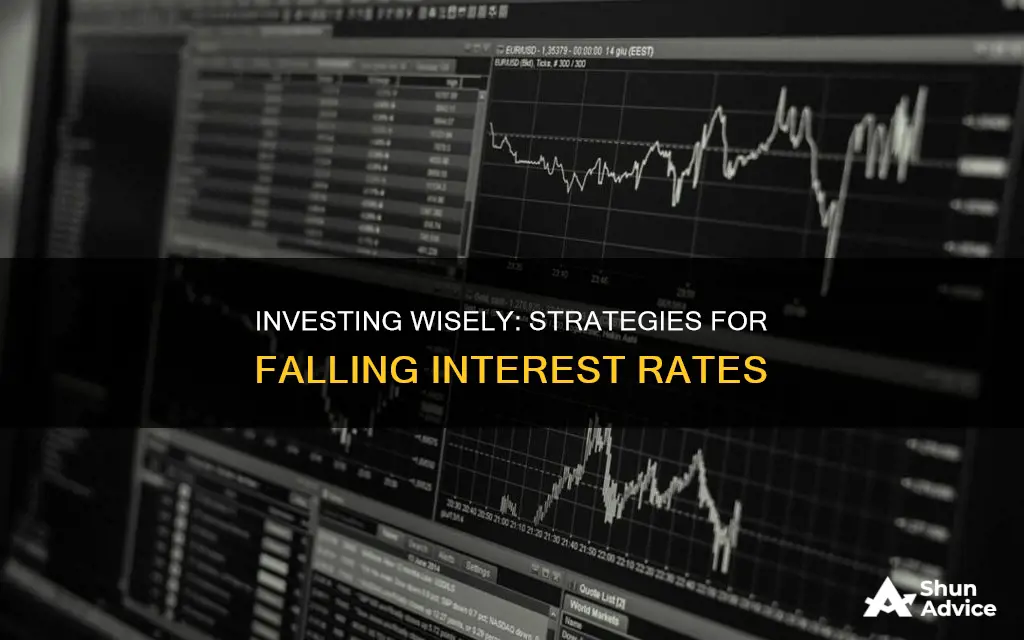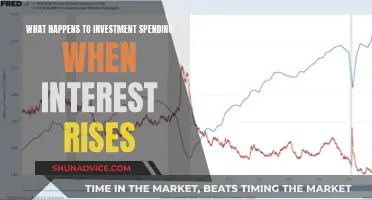
When interest rates fall, investors, businesses and consumers tend to welcome the change. This is because interest rates represent the cost of capital, so when they fall, there is more economic activity and faster economic growth. This can translate into higher corporate earnings and a bullish stock market. However, determining the appropriate level of interest rate risk is critical to avoid excess volatility and minimise the risk of negative returns. So, what are appropriate investments when interest rates fall?
| Characteristics | Values |
|---|---|
| Bonds | Previously issued, higher interest bonds become more valuable in relation to new ones, which pay a lower income |
| Bond funds | Bonds and bond funds are good investments when interest rates fall |
| Bond ladders | Can minimise the risk of rising interest rates, while maximising the income from a fixed income portfolio |
| High-yield bonds | May be appropriate investments if you want to capture yield |
| Dividend-paying stocks | May be appropriate investments if you want to capture yield |
| Real estate investment trusts (REITs) | REITs, home builders and home improvement retailers benefit from falling interest rates |
| Brokers | Brokers benefit from falling interest rates more than banks |
| Asset managers | Asset managers benefit from falling interest rates more than banks |
| Insurance companies | Insurance companies benefit from falling interest rates more than banks |
What You'll Learn

Bonds and bond funds
When interest rates fall, previously issued, higher interest bonds become more valuable in relation to new ones, which pay a lower income. This means that when interest rates go down, the general level of bond prices goes up.
Bond funds are a type of investment fund that invests in a portfolio of bonds. They can be a good investment when interest rates fall, as they provide exposure to a diverse range of bonds. This can help to reduce the risk of investing in individual bonds, as the performance of the fund is not dependent on the performance of a single bond.
Bond ladders are another way to invest in bonds when interest rates are falling. A bond ladder is a portfolio of bonds with different maturity dates. This can help to minimise the risk of rising interest rates, while maximising the income from a fixed income portfolio. However, like all other investments, bond ladders carry risks and may not be appropriate for all investors.
High-yield bonds may also be an appropriate investment when interest rates fall. These are bonds that offer a higher return, but they may be from riskier financial institutions.
Understanding Taxable Interest Income from Investments
You may want to see also

Real estate investment trusts (REITs)
When interest rates fall, it's generally good news for investors. Lower rates on business loans, bonds, credit cards and mortgages mean more economic activity and faster economic growth, which can translate into higher corporate earnings and a bullish stock market.
One type of investment that can do particularly well when interest rates fall is Real Estate Investment Trusts (REITs). REITs are companies that own and operate income-producing real estate. They are required to pay out at least 90% of their taxable income to shareholders as dividends, which can make them attractive to income-focused investors. When interest rates fall, rates on residential and commercial mortgages are sure to follow, which is usually good news for REITs.
REITs can be a good investment when interest rates are falling because they offer a high dividend yield. As interest rates fall, income-focused investors may look to REITs as an alternative to bonds, which offer a lower yield. Additionally, falling interest rates can lead to an increase in real estate transactions, which can benefit REITs.
It's important to note that REITs do carry risks, just like any other investment. For example, they may be subject to market risk, interest rate risk, and liquidity risk. Additionally, the performance of REITs can be impacted by economic conditions and the health of the real estate market. Therefore, it's important to carefully consider the risks and potential rewards before investing in REITs or any other type of investment.
There are other types of investments that can also be appropriate when interest rates fall. For example, previously issued, higher-interest bonds can become more valuable when interest rates fall, as the general level of bond prices goes up. High-yield bonds or dividend-paying stocks may also be appropriate investments when interest rates are falling.
Understanding Investment Mathematics: Compound Interest Explained
You may want to see also

High-yield bonds
When interest rates fall, previously issued, higher-interest bonds become more valuable in relation to new ones, which pay a lower income. This means that when interest rates go down, the general level of bond prices goes up.
When interest rates fall, high-yield bonds can become more attractive to investors. This is because the higher interest rates offered by these bonds can provide a higher level of income compared to other investments. Additionally, falling interest rates can lead to a more stable economic environment, which may reduce the risk associated with high-yield bonds.
It's important to note that high-yield bonds do carry a higher level of risk compared to investment-grade bonds. This risk is reflected in the credit rating of the bonds, which is typically below investment grade. As such, investors should carefully consider their risk tolerance and diversification strategies before investing in high-yield bonds.
Overall, high-yield bonds can be a suitable investment option when interest rates fall, offering the potential for higher income and capital appreciation. However, investors should be mindful of the additional risks associated with these bonds and ensure they are comfortable with the level of risk they are taking on.
Robinhood's Interest Policy: What Investors Need to Know
You may want to see also

Dividend-paying stocks
When interest rates fall, investors generally welcome the prospect of falling rates. Lower rates on business loans, bonds, credit cards and mortgages mean more economic activity and faster economic growth, which can translate into higher corporate earnings and a bullish stock market.
When considering dividend-paying stocks, it's important to look for companies with a strong track record of paying dividends and a history of increasing their dividend payments over time. It's also crucial to assess the financial health and stability of the company, as well as the overall industry outlook.
Additionally, dividend-paying stocks can be a good option for investors seeking a more stable investment strategy. Dividend-paying stocks tend to be less volatile than other stocks, as companies that pay dividends are often more established and have a consistent cash flow. This can make them a good choice for investors who are risk-averse or looking for a long-term investment strategy.
However, it's important to remember that dividend-paying stocks are not without risk. The company's performance and the overall market conditions can impact the dividend payments. Therefore, it's crucial to conduct thorough research and due diligence before investing.
Interest Rates, Investments, and Planned Spending: What's the Link?
You may want to see also

Bond ladders
When interest rates fall, investors, businesses and consumers tend to benefit. Lower rates on business loans, bonds, credit cards and mortgages mean more economic activity and faster economic growth, which can translate into higher corporate earnings and a bullish stock market.
One appropriate investment when interest rates fall is bond ladders. Bond ladders can minimise the risk of rising interest rates while maximising the income from a fixed-income portfolio. However, like all other investments, bond ladders carry risks and may not be appropriate for all investors.
A bond ladder is a portfolio of fixed-income investments with varying maturity dates. The goal of a bond ladder is to provide a steady stream of income over time, while also minimising the risk of rising interest rates. When interest rates are falling, the prices of previously issued, higher-interest bonds tend to increase in value relative to new ones, which pay a lower income. This can make them a more attractive investment option when interest rates are low.
To build a bond ladder, investors typically purchase a series of bonds with different maturity dates, ranging from short-term to long-term. For example, an investor might purchase bonds with maturities of one, two, three, four and five years. As each bond matures, the investor receives the principal amount back, plus any interest earned. This provides a regular stream of income over time.
Additionally, bond ladders can help to reduce the impact of interest rate risk. When interest rates rise, the price of existing bonds tends to fall. By having a mix of bonds with different maturity dates, investors can take advantage of rising interest rates without having to sell all of their bonds at once. This can help to minimise the impact of interest rate risk and provide a more stable investment portfolio.
Car Loan Interest: An Investment Strategy?
You may want to see also
Frequently asked questions
Falling interest rates generally benefit businesses, consumers and investors. Lower rates on business loans, bonds, credit cards and mortgages mean more economic activity and faster economic growth, which can translate into higher corporate earnings and a bullish stock market.
When interest rates fall, previously issued, higher interest bonds become more valuable in relation to new ones, which pay a lower income. This means that when interest rates go down, the general level of bond prices goes up.
When interest rates are low, high-yield bonds or dividend-paying stocks may be appropriate investments.
Like all other investments, bond ladders carry risks and may not be appropriate for all investors.
To avoid excess volatility and minimise the risk of negative returns, target a duration no greater than the investment time horizon.







